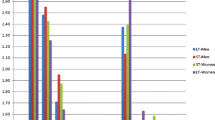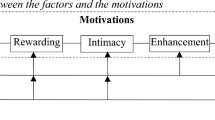Abstract
Historically, the reasons people have sex have been assumed to be few in number and simple in nature–to reproduce, to experience pleasure, or to relieve sexual tension. Several theoretical perspectives suggest that motives for engaging in sexual intercourse may be larger in number and psychologically complex in nature. Study 1 used a nomination procedure that identified 237 expressed reasons for having sex, ranging from the mundane (e.g., “I wanted to experience physical pleasure”) to the spiritual (e.g., “I wanted to get closer to God”), from altruistic (e.g., “I wanted the person to feel good about himself/herself”) to vengeful (e.g., “I wanted to get back at my partner for having cheated on me”). Study 2 asked participants (N = 1,549) to evaluate the degree to which each of the 237 reasons had led them to have sexual intercourse. Factor analyses yielded four large factors and 13 subfactors, producing a hierarchical taxonomy. The Physical reasons subfactors included Stress Reduction, Pleasure, Physical Desirability, and Experience Seeking. The Goal Attainment subfactors included Resources, Social Status, Revenge, and Utilitarian. The Emotional subfactors included Love and Commitment and Expression. The three Insecurity subfactors included Self-Esteem Boost, Duty/Pressure, and Mate Guarding. Significant gender differences supported several previously advanced theories. Individual differences in expressed reasons for having sex were coherently linked with personality traits and with individual differences in sexual strategies. Discussion focused on the complexity of sexual motivation and directions for future research.
Similar content being viewed by others
Notes
The 142-item YSEX? Questionnaire is available from the corresponding author.
Available from the corresponding author upon request.
References
Baker, R. R., & Bellis, M. A. (1995). Human sperm competition. London: Chapman & Hall.
Basson, R. (2000). The female sexual response: A different model. Journal of Sex and Marital Therapy, 26, 51–65.
Baumeister, R. F., & Vohs, K. D. (2004). Sexual economics: Sex as female resource for social exchange in heterosexual interactions. Personality and Social Psychology Review, 8, 339–363.
Betzig, L. (1989). Causes of conjugal dissolution. Current Anthropology, 30, 654–676.
Burley, N., & Symanski, R. (1981). Women without: An evolutionary and cross-cultural perspective on prostitution. In I. R. Symanski (Ed.), The immoral landscape: Female prostitution in Western societies (pp. 239–274). Toronto: Butterworth.
Buss, D. M. (1989a). Conflict between the sexes: Strategic interference and the evocation of anger and upset. Journal of Personality and Social Psychology, 56, 735–747.
Buss, D. M. (1989b). Sex differences in human mate preferences: Evolutionary hypotheses testing in 37 cultures. Behavioral and Brain Sciences, 12, 1–49.
Buss, D. M. (2003). The evolution of desire: Strategies of human mating (rev. ed.). New York: Basic Books.
Buss, D. M. (2005). The murderer next door: Why the mind is designed to kill. New York: Penguin.
Buss, D. M., & Schmitt, D. P. (1993). Sexual strategies theory: An evolutionary perspective on human mating. Psychological Review, 100, 204–232.
Buss, D. M., & Shackelford, T. K. (1997). From vigilance to violence: Mate retention tactics in married couples. Journal of Personality and Social Psychology, 72, 346–361.
Carroll, J. L., Volk, K. D., & Hyde, J. S. (1985). Differences between males and females in motives for engaging in sexual intercourse. Archives of Sexual Behavior, 14, 131–139.
Denney, N. W., Field, J. K., & Quadagno, D. (1984). Sex differences in sexual needs and desires. Archives of Sexual Behavior, 13, 233–245.
Gangestad, S. W., & Simpson, J. A. (1990). Toward an evolutionary history of female sociosexual variation. Journal of Personality, 58, 69–96
Gangestad, S. W., & Simpson, J. A. (2000). The evolution of human mating: Trade-offs and strategic pluralism. Behavioral and Brain Sciences, 23, 675–687.
Greiling, H., & Buss, D. M. (2000). Women’s sexual strategies: The hidden dimension of extra-pair mating. Personality and Individual Differences, 28, 929–963.
Hamann, S., Herman, R. A., Nolan, C. L., & Wallen, K. (2004). Men and women differ in amygdala response to visual sexual stimuli. Nature Neuroscience, 7, 411–416.
Hatfield, E., & Rapson, R. L. (1996). Love and sex: Cross-cultural perspectives. Boston: Allyn & Bacon.
Hill, C. A., & Preston, L. K. (1996). Individual differences in the experience of sexual motivation: Theory and measurement of dispositional sexual motives. Journal of Sex Research, 33, 27–45.
Hill, K., & Hurtado, A. M. (1996). Ache life history: The ecology and demography of a foraging people. New York: Aldine De Gruyter.
John, O. P., Donahue, E. M., & Kentle, R. (1991). The Big Five Inventory. Technical report, University of California, Berkeley.
Leary, M. R., & Downs, D. L. (1995). Interpersonal functions of the self-esteem motive: The self-system as a sociometer. In M. H. Kernis (Ed.), Efficacy, agency, and self-esteem (pp. 123–144). New York: Plenum.
Leigh, B. C. (1989). Reasons for having and avoiding sex: Gender, sexual orientation, and relationship to sexual behavior. Journal of Sex Research, 26, 199–209.
Little, B. (2005). Personality science and personal projects: Six impossible things before breakfast. Journal of Research in Personality, 39, 4–21.
Low, B. S. (1989). Cross-cultural patterns in the training of children: An evolutionary perspective. Journal of Comparative Psychology, 103, 313–319.
Meston, C. M., Heiman, J. R., Trapnell, P. D., & Paulhus, D. L. (1998). Socially desirable responding and sexuality self-reports. Journal of Sex Research, 35, 148–157.
Meston, C. M., Trapnell, P. D., & Gorzalka, B. B. (1993). Sex and the five factor model of personality. Poster session presented at the annual meeting of the International Academy of Sex Research, Pacific Grove, CA.
Meston, C. M., Trapnell, P. D., & Gorzalka, B. B. (1998). Ethnic, gender, and length-of-residency influences on sexual knowledge and attitudes. Journal of Sex Research, 35, 176–188.
Nunnally, J. C. (1978). Psychometric theory. New York: McGraw Hill.
Schmitt, D. P. (2004). Patterns and universals of mate poaching across 53 nations: The effects of sex, culture, and personality on romantically attracting another person. Journal of Personality and Social Psychology, 86, 560–584.
Schmitt, D. P., Alcalay, L., Alik, J., Ault, L., Austers, I., Bennett, K. L., et al. (2003). Universal sex differences in the desire for sexual variety: Tests from 52 nations, 6 continents, and 13 islands. Journal of Personality and Social Psychology, 85, 85–104.
Schmitt, D. P., & Buss, D. M. (2001). Human mate poaching: Tactics and temptations for infiltrating existing relationships. Journal of Personality and Social Psychology, 80, 894–917.
Schmitt, D. P., Shackelford, T. K., Duntley, J., Tooke, W., & Buss, D. M. (2001). The desire for sexual variety as a tool for understanding basic human mating strategies. Personal Relationships, 8, 425–455.
Shackelford, T. K., Pound, N., Goetz, A. T., & LaMunyon, C. W. (2005). Female infidelity and sperm competition. In D. M. Buss (Ed.), The handbook of evolutionary psychology (pp. 372–393). New York: Wiley.
Simpson, J. A., & Gangestad, S. W. (1991). Individual differences in sociosexuality: Evidence for convergent and discriminant validity. Journal of Personality & Social Psychology, 60, 870–883.
Symons, D. (1979). The evolution of human sexuality. New York: Oxford.
Townsend, J. (1998). What women want–what men want: Why the sexes still see love and commitment so differently. Oxford: Oxford University Press.
Trivers, R.L. (1972). Parental investment and sexual selection. In B. Campbell (Ed.), Sexual selection and the descent of man: 1871–1971 (pp. 136–179). Chicago: Aldine.
Wilson, M., & Daly, M. (1992). The man who mistook his wife for a chattel. In J. Barkow, L. Cosmides, & J. Tooby (Eds.), The adapted mind (pp. 289–322). New York: Oxford.
Author information
Authors and Affiliations
Corresponding author
Appendix
Appendix





Rights and permissions
About this article
Cite this article
Meston, C.M., Buss, D.M. Why Humans Have Sex. Arch Sex Behav 36, 477–507 (2007). https://doi.org/10.1007/s10508-007-9175-2
Received:
Revised:
Accepted:
Published:
Issue Date:
DOI: https://doi.org/10.1007/s10508-007-9175-2




